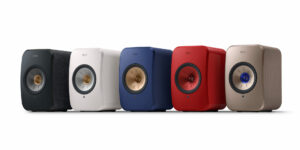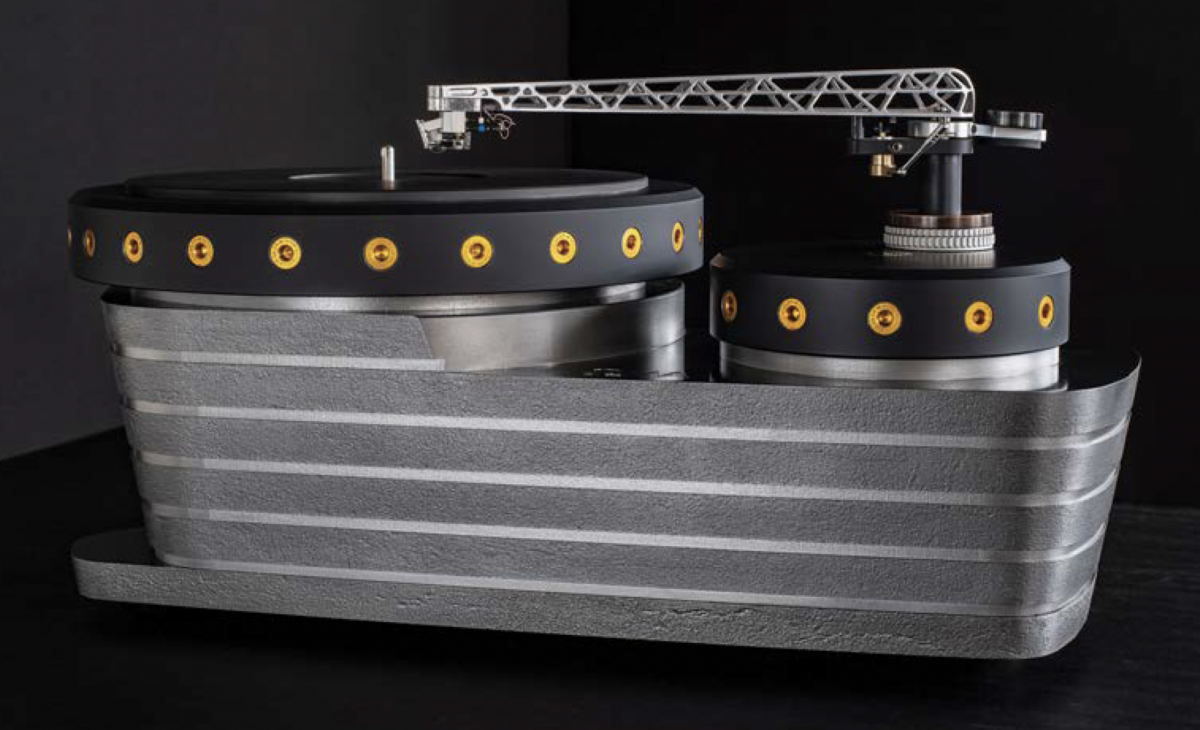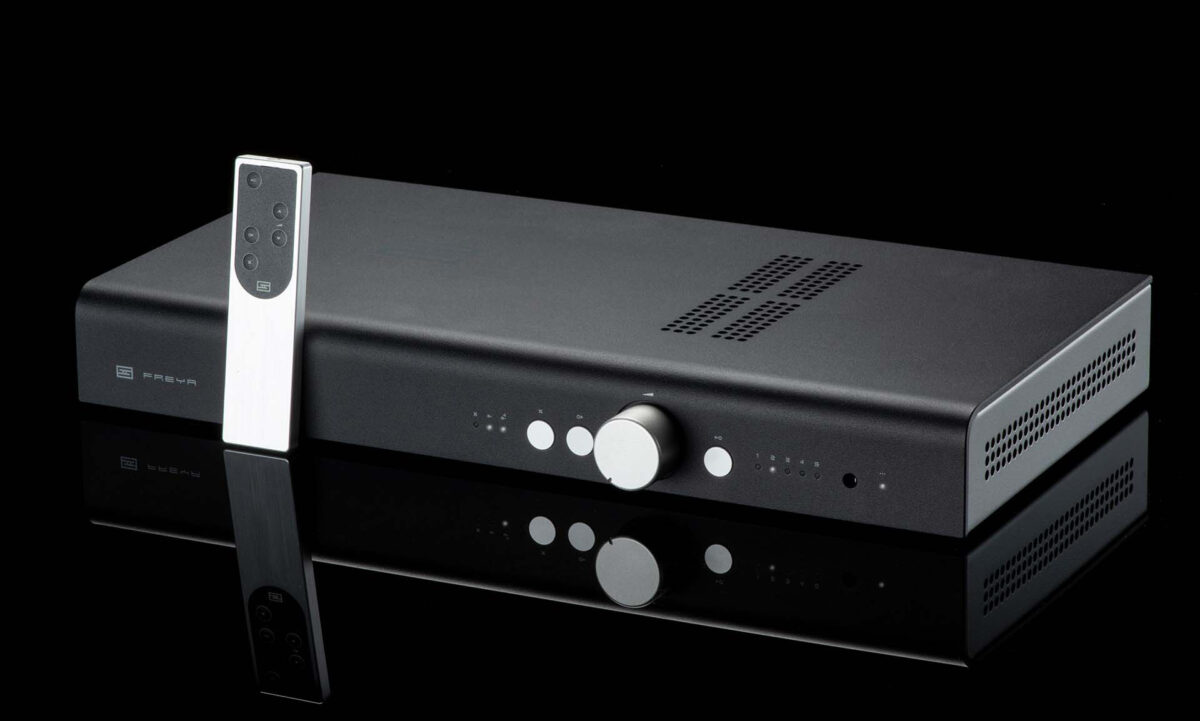
I first reviewed the original KEF LSX back in 2019 and had nothing but good things to say about it. True, wireless speakers were relatively new at that point. There weren’t a ton of competitors on the market, and at the time I felt like KEF nailed the sound, look, and experience. Since then, I’ve nominated the LSXes multiple times for Golden Ear awards, and I still think they hold up as fantastic streaming speakers with great sound. Obviously, when asked to review the KEF LSX IIs ($1399), I basically dropped everything, told my family I would not speak with them for at least a month, collected canned goods and bottled water, and began to hibernate with nothing but an Internet connection and some acoustic-treatment panels. Were the KEFs worth this self-imposed and totally needless (also not real) break from reality? Probably, but it never happened, so we’ll never find out.
Like the original version, the LSX IIs are compact bookshelf speakers. My review samples were wrapped in an attractive fabric around the top and sides, with a smooth matte finish on the baffle. Three models are fabric covered, one has a gloss red finish, and one has a satin matte enclosure. The Uni-Q driver is the real star and central focus, with only a small LED light that remains off most of the time but acts as a function signal. My review pair were Cobalt Blue—honestly, they looked incredible—but there are five colors to choose from. Visually, they’re not drastically different from the original LSX, which is a good thing because KEF got their looks right the first time. The back of the primary speaker includes several physical connections: HDMI ARC, USC-C for laptops and other devices, optical, AUX, and a subwoofer output. And that’s only the tip of the LSX II’s connectivity iceberg. If I tried to list all the streaming options, you’d be stuck reading this review forever. But here are the highlights: Bluetooth, AirPlay 2, Chromecast, Roon Ready, UPnP, along with all the major streaming services. Like I said, it’s a lot, but that’s a good thing—the amount of time I spent trying to access my music was basically zero, and that’s exactly what I wanted.
Beyond streaming, the LSX II supports a ton of formats, including MQA, DSD, FLAC, WAV, Ogg Vorbis, and a bunch of other acronyms. If you have a specific niche acronym you’re really into, check the KEF website. In wireless mode, sources are resampled to 48kHz/24-bit PCM; in wired mode, that changes to 96kHz/24-bit, which means you need the fancy CAT6 tether for maximum sound quality. I tested this out, and there was a small audible difference—small enough that I didn’t feel the need to leave it connected. That said, I found the tether was reasonably long (it works up to 10 meters); it would be easy to keep the speakers plugged together, and the tether hidden on either side of a television console, for example, although I did most of my listening in the wireless mode, and all the notes below are untethered. I wanted my LSX IIs to be free.
Some final details: The LSX IIs are compatible with both 2.4GHz and 5GHz Wi-Fi and all the latest fancy network standard letters, which means they can stream as fast as your router can pump out those waves. Frequency response is claimed to be 54Hz–28kHz, and those numbers feel representative of my experience—there’s a reason the LSX IIs come with a sub output. If you’re looking for life-changing bass, these won’t get you there, but I will say that I was extremely and pleasantly surprised by how well the LSX IIs handled the extreme ends of the sound spectrum and never really yearned for deeper bass during my listening, except when engaging with quiet acoustic music, but I’ll get to that. As always, individual tastes vary.

That was a lot of technical data. Here’s the thing though: The LSX IIs are half hardware and half software. These are technical speakers, essentially part computer and part output device, and the software is deeply embedded and meshed into the listening experience. All that stuff I listed above basically disappears because it all works invisibly. Which brings me to the set-up portion of the review—and this is the first time the LSX IIs really outshone their LSX counterparts. The box unfolded and allowed the speakers to be easily lifted out. I got them placed on their stands, plugged them into the wall (yes, both individual speakers have a power cord, keep that in mind), and powered them up. I needed a smartphone to download the KEF Connect app, and from there it was brainlessly simple—my favorite kind of simple. With the original LSX, I needed to tether them together to make sure they were properly updated and installed, but that’s no more. The LSX II updated seamlessly and wirelessly, meaning once they were put in place, untethered, and ready to go, I never had to worry about taking them out and tethering them together again.
And I will say that the KEF Connect app is actually pretty good. I’ve been very critical of hardware manufacturers making apps, but KEF really surprised me here. The app is nicely designed and configured in such a way that a real, non-techie human would actually be able to use it. All the speaker controls are in the settings—from volume to performance to updates to preferences. There are detailed EQ tweaks in the expert mode, from the subwoofer-out low-pass frequency to bass extension to treble trim and so on, and a much more simplified experience in normal DSP mode. I messed around with EQ but ultimately didn’t take listening notes using any of my EQ tweaks (though I was very tempted to leave them in place). I will say that I barely used the app, even though it is objectively nice and well done. KEF calls the LSX II plug-and-play, and that is completely right. The speakers sound nice right out of the box, and setup is incredibly easy. And now updates don’t require the tether-dance! Honestly, the quality-of-life improvements were absolutely worthwhile, already.
But on to what everyone cares about: How do they sound? My initial impressions were that the LSX IIs aren’t hugely different from the original LSXes. Not on the surface anyway. They look the same, use the same amplification and driver system, and have similar physical connectivity. There are differences—and I’ll get to them—but overall, they have a very similar sound, and that makes a lot of sense: They use the same basic drivers. The real changes come in the shape of software, most importantly a redesigned DSP system and some other minor tweaks under the hood. And that, folks, is a very good thing. I loved the original LSXes for their true wirelessness, their simplicity, and their bigger-than-you’d-think sound. The LSX IIs take all of that and elevate it and refine it, including the big sound, the crisp mids, the toe-tapping rhythm, and everything else that made the originals so good. The LSX IIs were what I loved about the originals but better.

The beauty of true wireless streaming like that of the LSX IIs is the sheer volume of music available on all the platforms, and so much of it is high-resolution these days. Gone are glitchy MP3s downloaded off Napster, which may or may not include the track you wanted. I stuck with Tidal for most of this review, though I also listened to music off Qobuz and my personal NAS system. Anyway, I started with the album Most Normal by Gilla Band, which is an Irish post-punk rock band. On “Almost Soon,” the drums were a solid and driving backbone holding together singer Dara Kiely’s spoken, shouted, and belted lyrics, while grinding, fully distorted guitars growled and chugged in the background. It’s a strangely warped album, alternating between spare and complicated with just about every effect in the world thrown into the mix, and the LSX IIs did a great job of keeping each instrument and sound in its proper place. I was surprised by the imaging at first, but quickly got used to its very tight soundstage and its extremely wide landscape. What could come off as a mushy mess sounded tight and exciting through the LSX IIs, and I felt their sense of rhythm really shone brightly. I suspect this had to do with KEF’s new DSP system error-correcting in the background and keeping everything in phase, and it worked wonderfully throughout Most Normal’s strange and shifting kaleidoscope of sound and noise.
Next, I put on the track “Iris” by The Goo Goo Dolls, because it remains a fantastic song, and you’re wrong if you disagree, and anyway, the guitars had a really pleasant acoustic twang, and the strings sang in the background with a slow and graceful lilt, which means the mids were locked in tight. The drums never quite dug down deep, although the LSX IIs do have a bass extension option in their DSP settings, but this didn’t bother me too much—they’re small all-in-ones, and I didn’t expect room-shaking low end. I never felt like I was missing an entire audio spectrum, and the LSX IIs got plenty loud enough to fill my fairly large listening space. I rolled right into “Slide” next and felt the tambourine in the background was a touch muted, a little soft, but the singer’s voice was solidly centered, and when the drums dropped in, I got a good palpable sense of body and weight. Overall, I was grooving like I was 10 years old again, listening to the radio in my parents’ laundry room while playing StarCraft on their PC, which might’ve been my peak.
Sticking with rock from my glory days, I put on the track “A Favor House Atlantic” by Coheed and Cambria. Singer Claudio Sanchez’s borderline falsetto is the star of this song, and his forceful singing is a hurricane in itself. The guitars sounded big and bold, and the drumming was taut, and I was satisfied by how large and expansive the LSX IIs sounded if pushed. This album, In Keeping Secrets of Silent Earth: 3, is cinematic in scope, and it begs for big, bold, room-crushing presentation. The LSX IIs aren’t going to break any windows, but they definitely would wake up my kids if I played them loud during nap time, which actually happened once—thanks KEF (I’m blaming you for my poor choices). During the track “Cuts Marked in the March of Men,” Sanchez’s voice zoomed and built and chorused over itself into epic heights as the guitars churned and burned underneath, and the LSXs gave me a good sense of planetary scope even without plumbing the lowest depths of the sound spectrum.
One thing worth noting: As I was finishing up this review, Roon officially green-lit the LSX IIs, and I decided to hold off and give it a listen for a few days to get a sense of how it worked. It sounded great, but there were some glitches. In particular, streaming MQA tracks saw the rendering system drop a few times, though streaming those same tracks on the Tidal app didn’t cause the same pauses and dropouts. I suspect this is a Roon issue and not KEF’s fault, and I’m sure it’ll get a software patch soon. It’s also worth pointing out that anything with a software focus can inevitably have some minor problems—but those minor problems more often than not get fixed.
I loved my time with the LSX IIs. The best pieces of equipment get slotted into my listening room and basically disappear if I’m not actively taking listening notes and comparing them to other gear. They become the medium through which I’m enjoying music and nothing else. The LSX IIs vanished almost the second they were set up, and I got over the brief learning curve and really dove into what they can do. After a day, their novelty wore off, and I found myself listening to music for the fun of it, and that’s really the biggest takeaway from this entire review. I was delighted by their sound, their ease-of-use, and all the important improvements KEF worked into the LSX IIs. If anyone’s looking for a pair of wireless speakers that can do just about anything at a genuinely reasonable price, these should be at the top of the list.
Specs & Pricing
Drivers: Uni-Q driver array (19mm aluminum dome and 115mm magnesium/aluminum alloy cone)
Frequency response: 54Hz–28kHz (±3dB, depending on EQ settings)
Amplifier output power: 70W/30W, Class D
Wireless streaming: AirPlay 2, Google Chromecast, Roon Ready, UPnP compatible, Bluetooth 4.2
Source resolutions: Network up to 384kHz/24bit; optical up to 96kHz/24bit; USB Type C up to 192kHz/24bit; HDMI up to 1.411Mbps PCM
Supported formats: MQA, DSD, FLAC, WAV, AIFF, ALAC, AAC, WMA, MP3, M4A, LPCM and Ogg Vorbis
Dimensions: 9.5″ × 6.1″ × 7.1″
Weight: 15.6 lbs. (per pair)
Price: $1399
KEF
10 Timber Lane
Marlboro, NJ, 07746
(732) 683-2356
kef.com
Tags: KEF LOUDSPEAKER STAND-MOUNT WIRELESS

By Drew Kalbach
I have a degree in English from Temple University and a Masters in Fine Arts with a specialty in poetry from the University of Notre Dame. I’m a full-time self-published author with over 100 books in both romance and men’s adventure fiction.
More articles from this editorRead Next From Review
See all
Oswalds Mill Audio K3 Turntable
- Apr 12, 2024

2023 Golden Ear: Schiit Freya S Preamplifier
- Apr 12, 2024




















